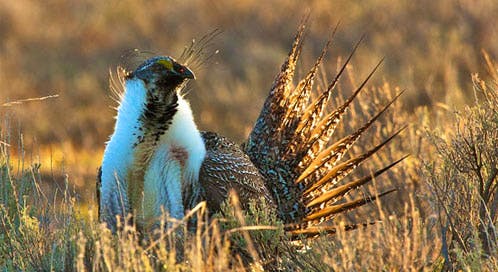Noah Matson, Vice President of Landscape Conservation & Climate Adaptation
This year we celebrate the 40th anniversary of the Endangered Species Act (ESA). The University of California-Davis School of Law hosted an important seminar this month marking this milestone in the Act’s history. The agenda for “ESA at 40: Examining its Past and Exploring its Future” was loaded with timely presentations offered by an impressive slate of conservation leaders, practitioners and luminaries, including Defenders of Wildlife President, Jamie Rappaport Clark.
Jamie’s presentation was focused on the role of carefully crafted, scientifically viable and publicly transparent conservation agreements made to protect and restore candidate species and their habitat—that is, species that are candidates for protection, but are not yet listed under the Endangered Species Act. Former Secretary of the Interior Bruce Babbitt spoke on a similar topic in his keynote address, and used the current sage-grouse planning process to highlight problems with conservation planning that lacks key ingredients for success.
The former Secretary reminded attendees that “perhaps the most important lesson learned from the last forty years is that most species have become endangered through loss of habitat.” It’s a simple truism, but one that is often forgotten amid the cacophony of opposition to species protection.
It follows then, that a successful conservation strategy must, first and foremost, adopt enforceable, minimum standards to protect habitat. Conservation planning, cannot, as Mr. Babbitt noted, “be reduced to a process of political bargaining in search for the lowest common denominator of agreement.”
However, it seems that’s where the federal National Greater Sage-Grouse Planning Strategy may be headed…
The Bureau of Land Management (BLM) is responsible for half of remaining sage-grouse habitat, and the Forest Service manages an additional 10 percent. These agencies are trying to avoid a listing for sage-grouse by initiating a massive planning process to update more than 100 land use and management plans with new measures to conserve the species. Unfortunately, and although more attention to conservation is usually a good thing, the sage-grouse plans released to date leave much to be desired.
As Mr. Babbitt explained, the BLM, “eager to avoid controversy,” has pursued a strategy “notable mainly for its lack of prescriptions to conserve sage-grouse” and “delegated planning to agency managers across the West without delineating minimum standards that must be included if plans are to be successful.” In other words, the new plans must do more to protect sage-grouse from habitat loss and degradation.
Mr. Babbitt summarized the problem as only the former Secretary can: “it is little short of fantasy to imagine that local and state BLM offices, without clear guidance from Washington, and under pressure from drillers, miners, ranchers and other resource users, can propose management prescriptions that will meet the legal test of the ESA.”
Fortunately, the former Secretary also explained what an improved sage-grouse planning process should look like. He recommended that federal agencies need to roll up individual sage-grouse plans into a single, range-wide conservation strategy. This would help eliminate the inconsistencies and inadequacies in individual plans. And he urged the Obama administration to specially protect the most essential habitat for sage-grouse. A system of sagebrush reserves would benefit sage-grouse and hundreds of other species that use sagebrush habitat.
As Mr. Babbitt concluded, “the sage-grouse and the Sagebrush Sea of the inland West are an enduring part of our natural heritage and must be preserved.” We agree, and the current sage-grouse planning process, if done correctly, is an unprecedented opportunity to advance this goal.





